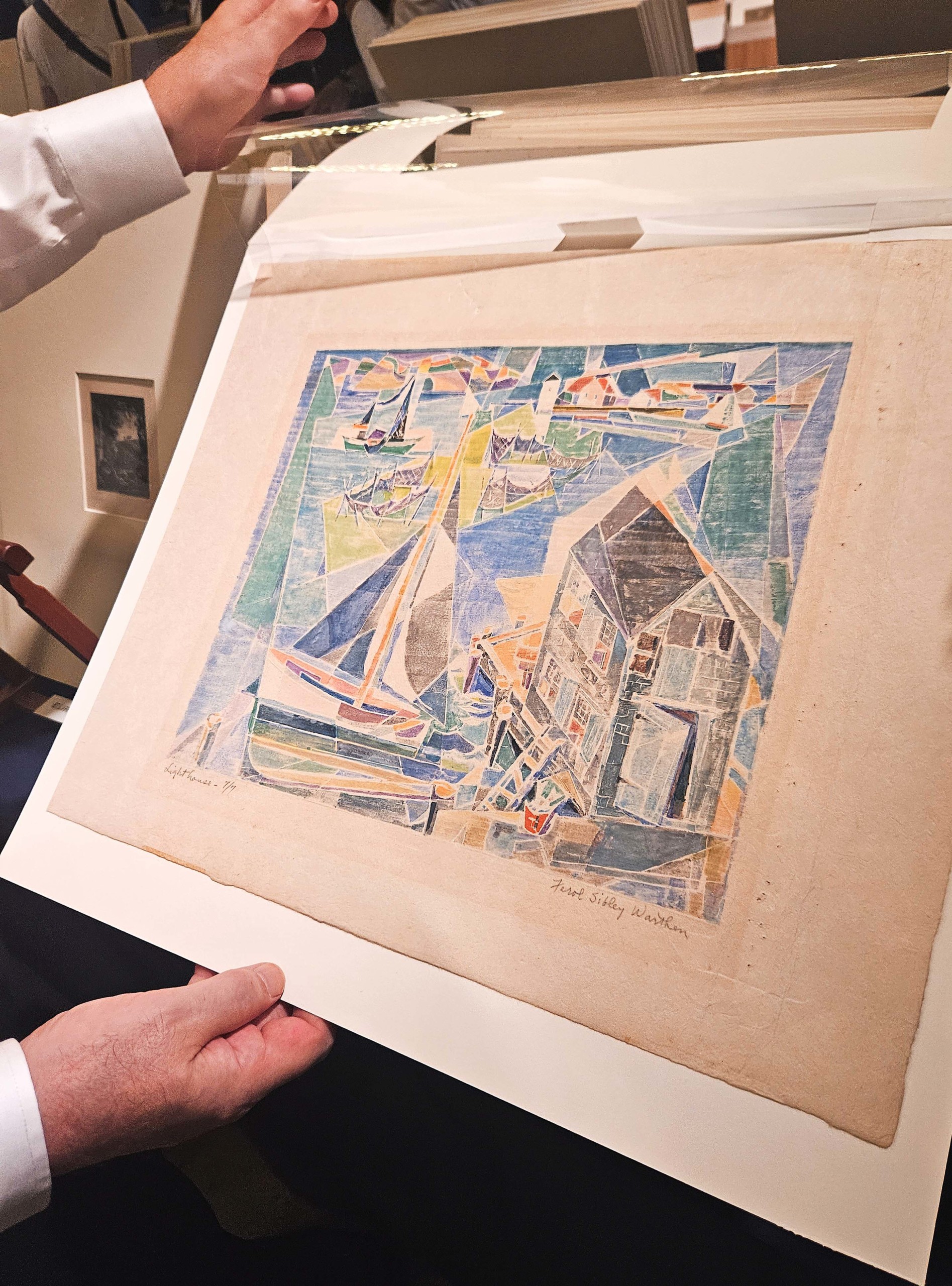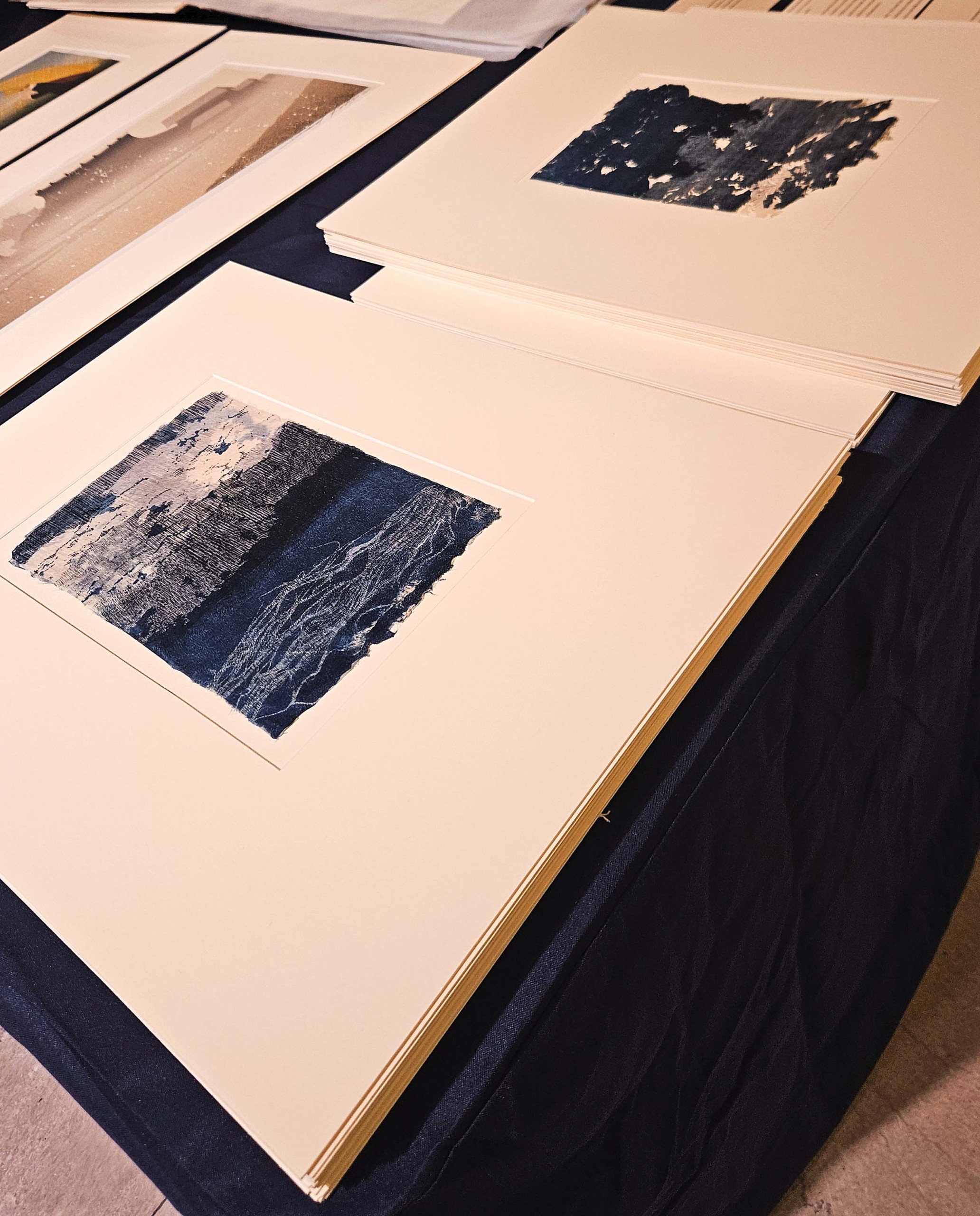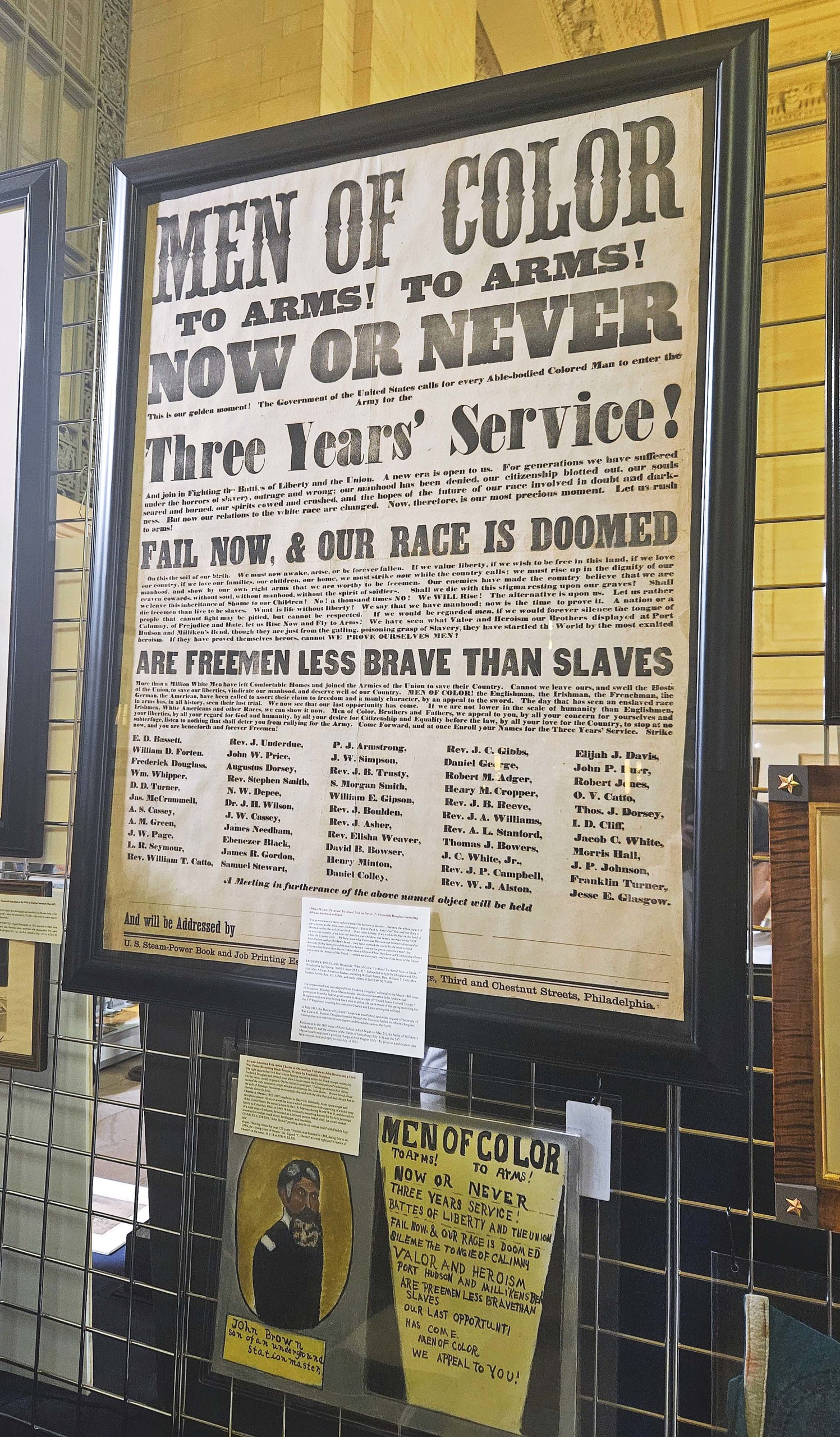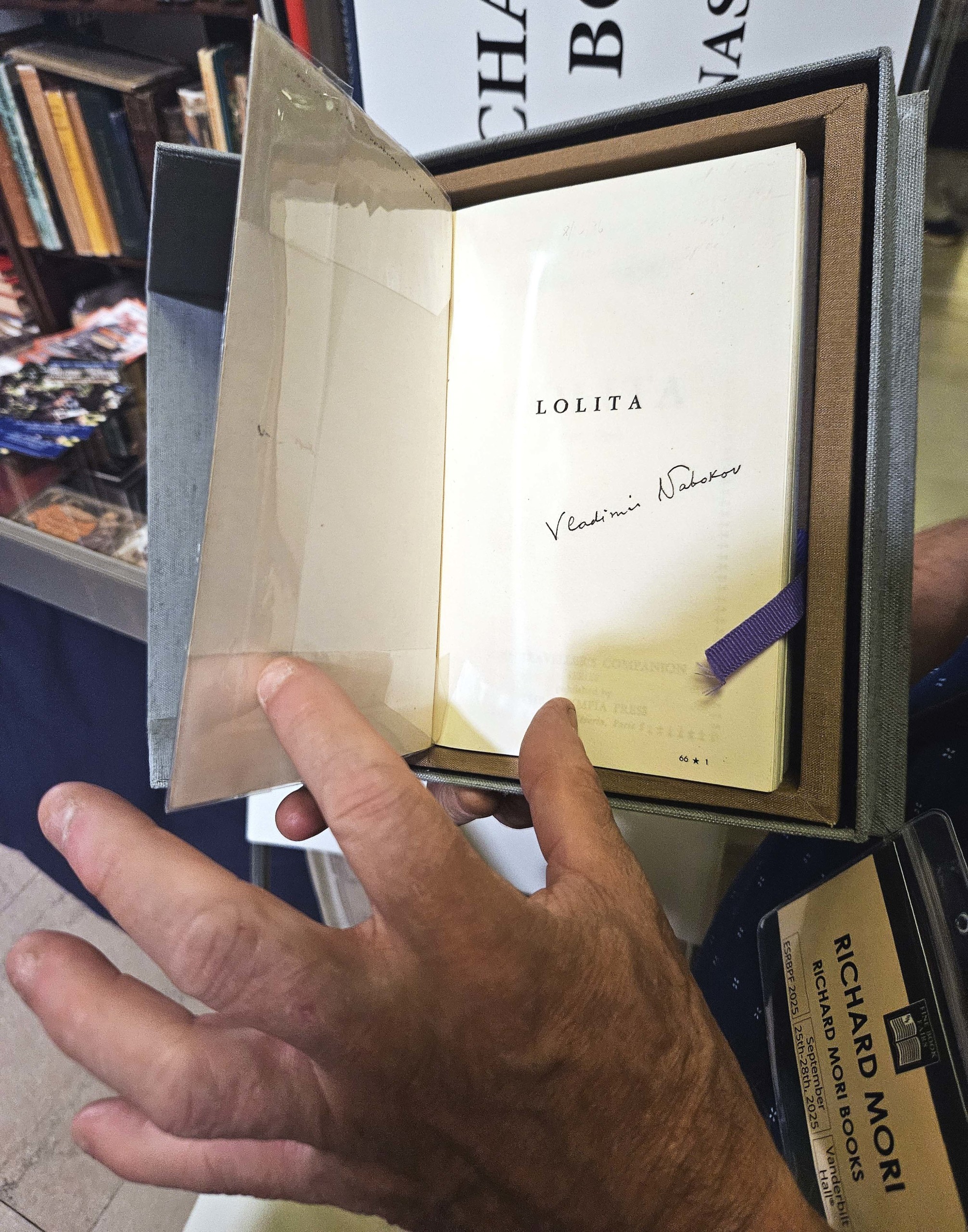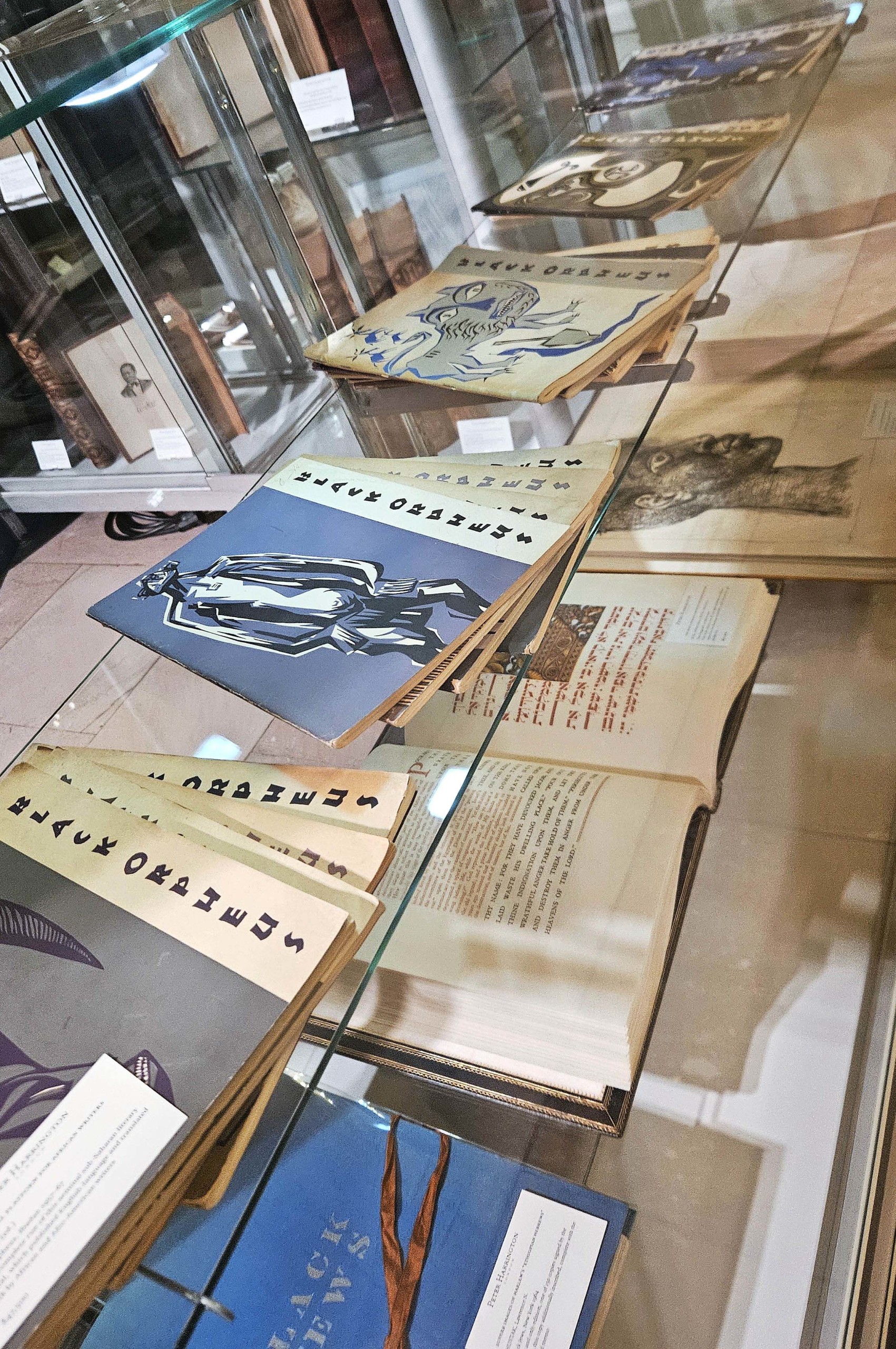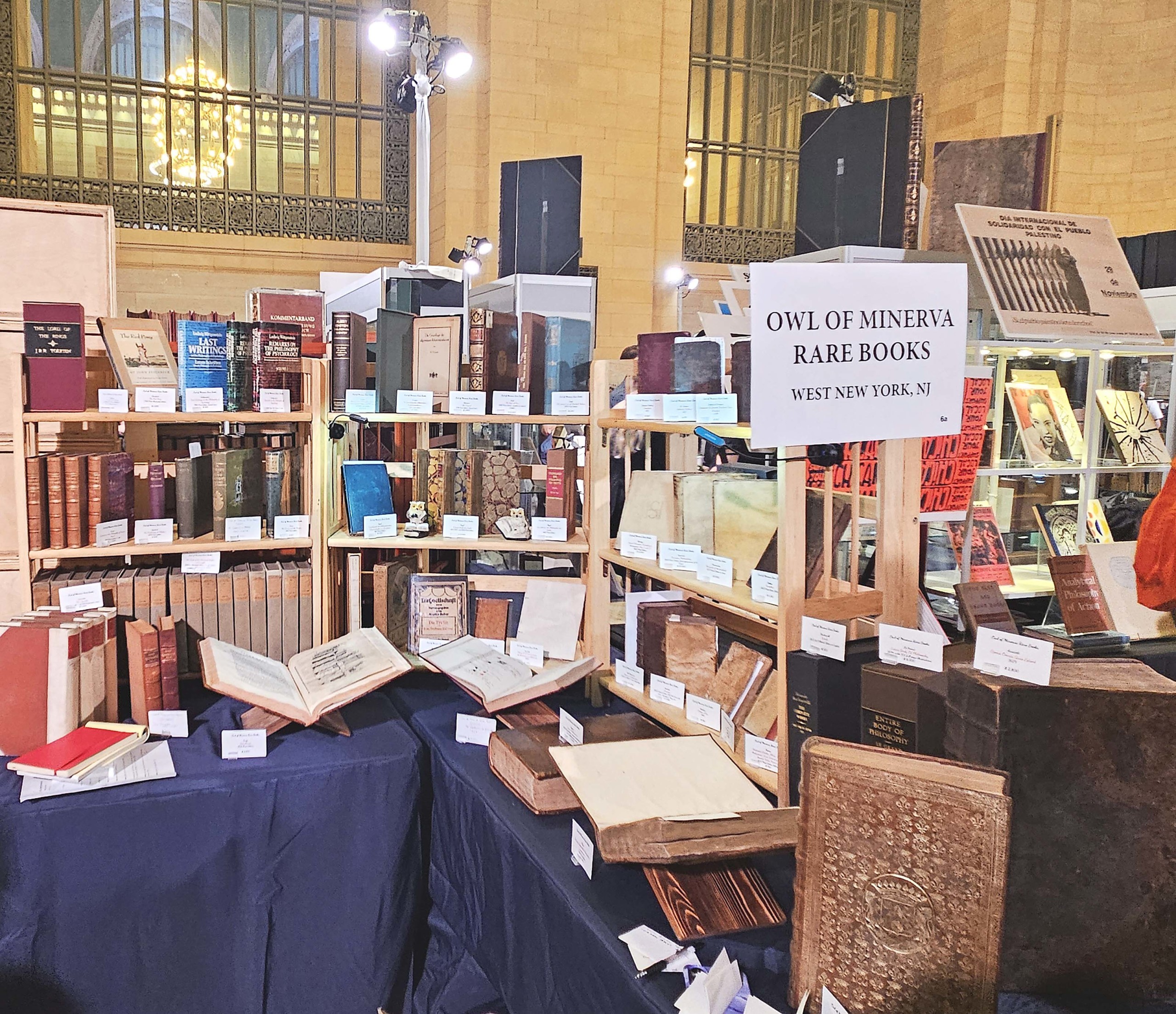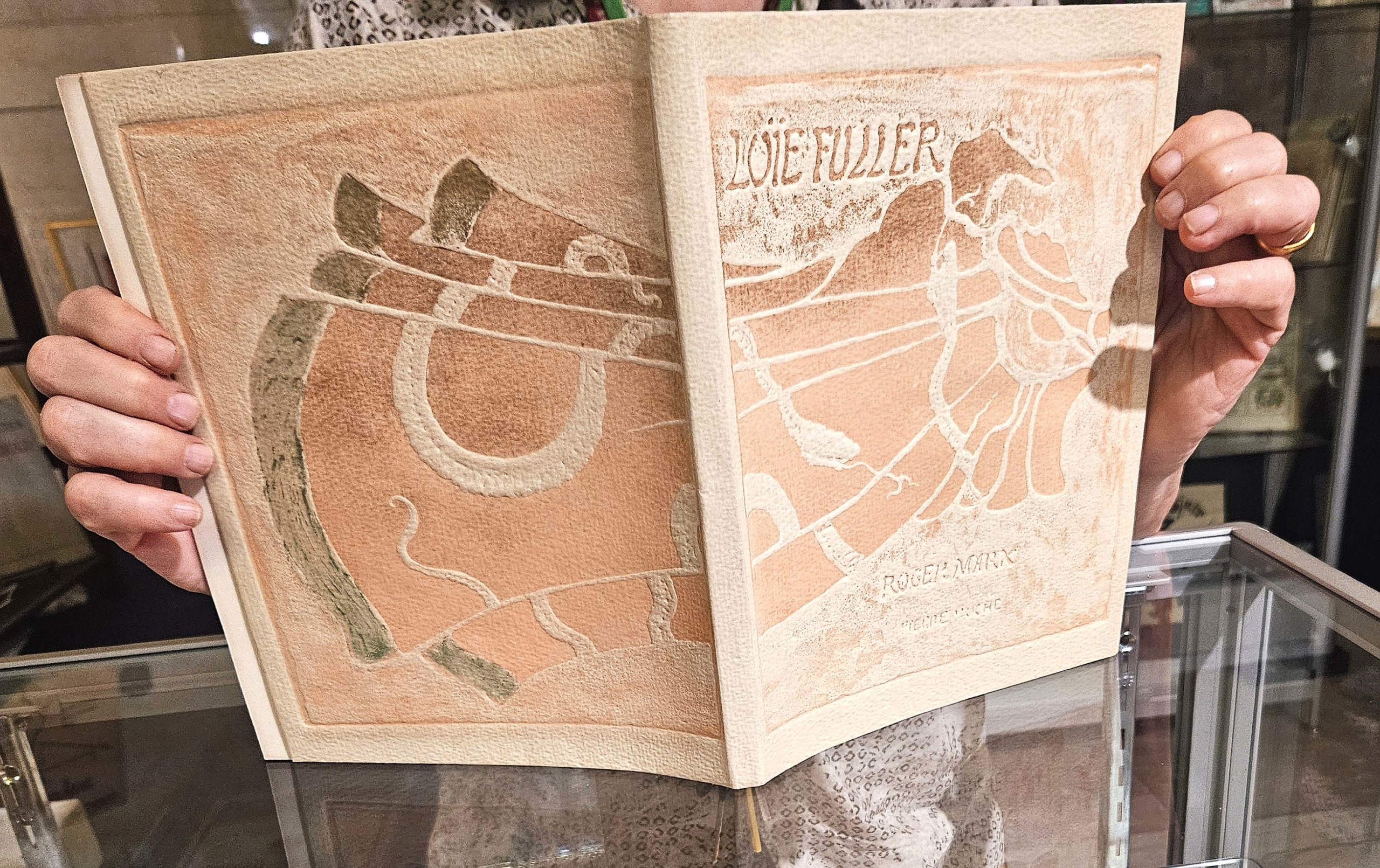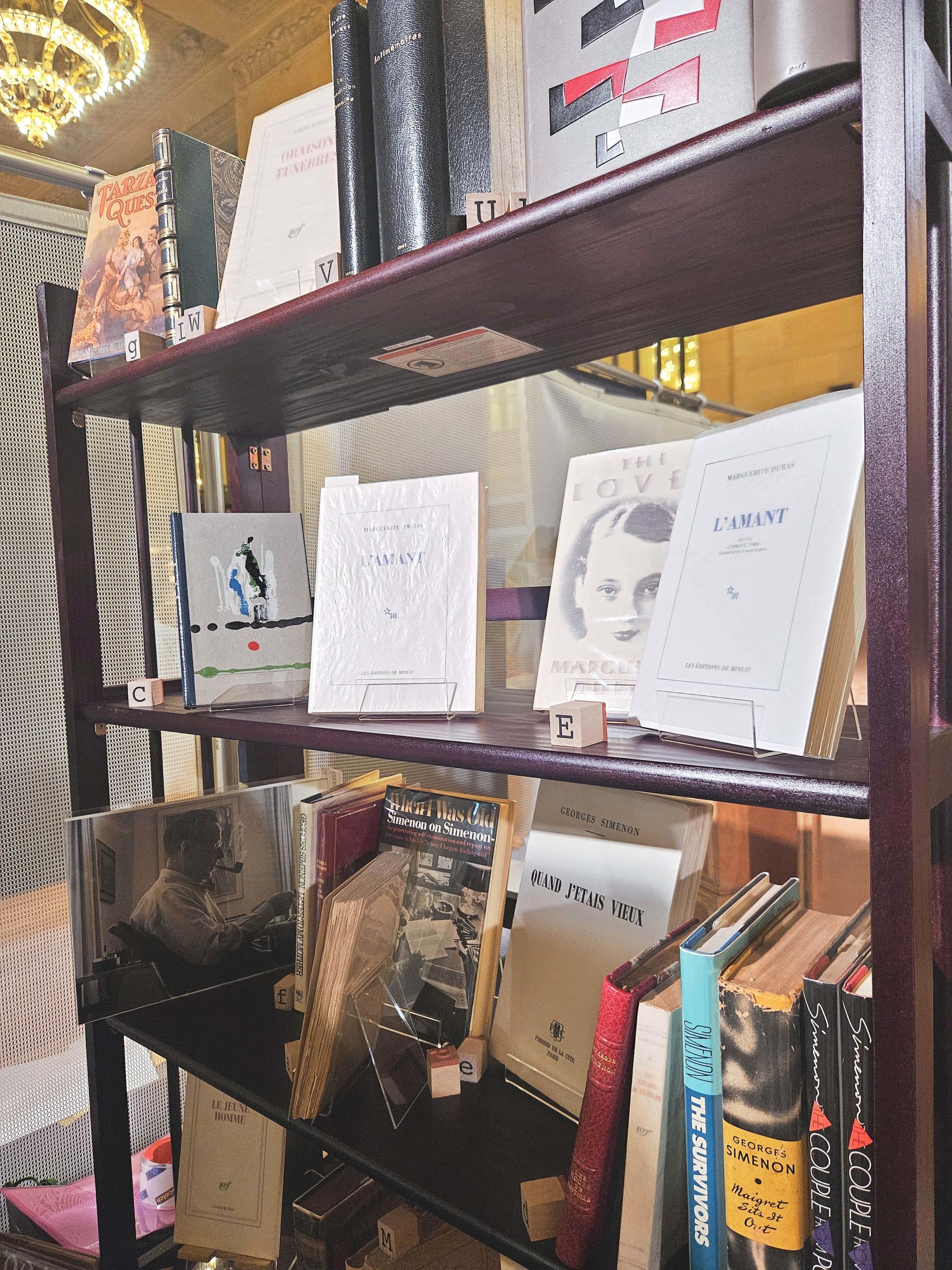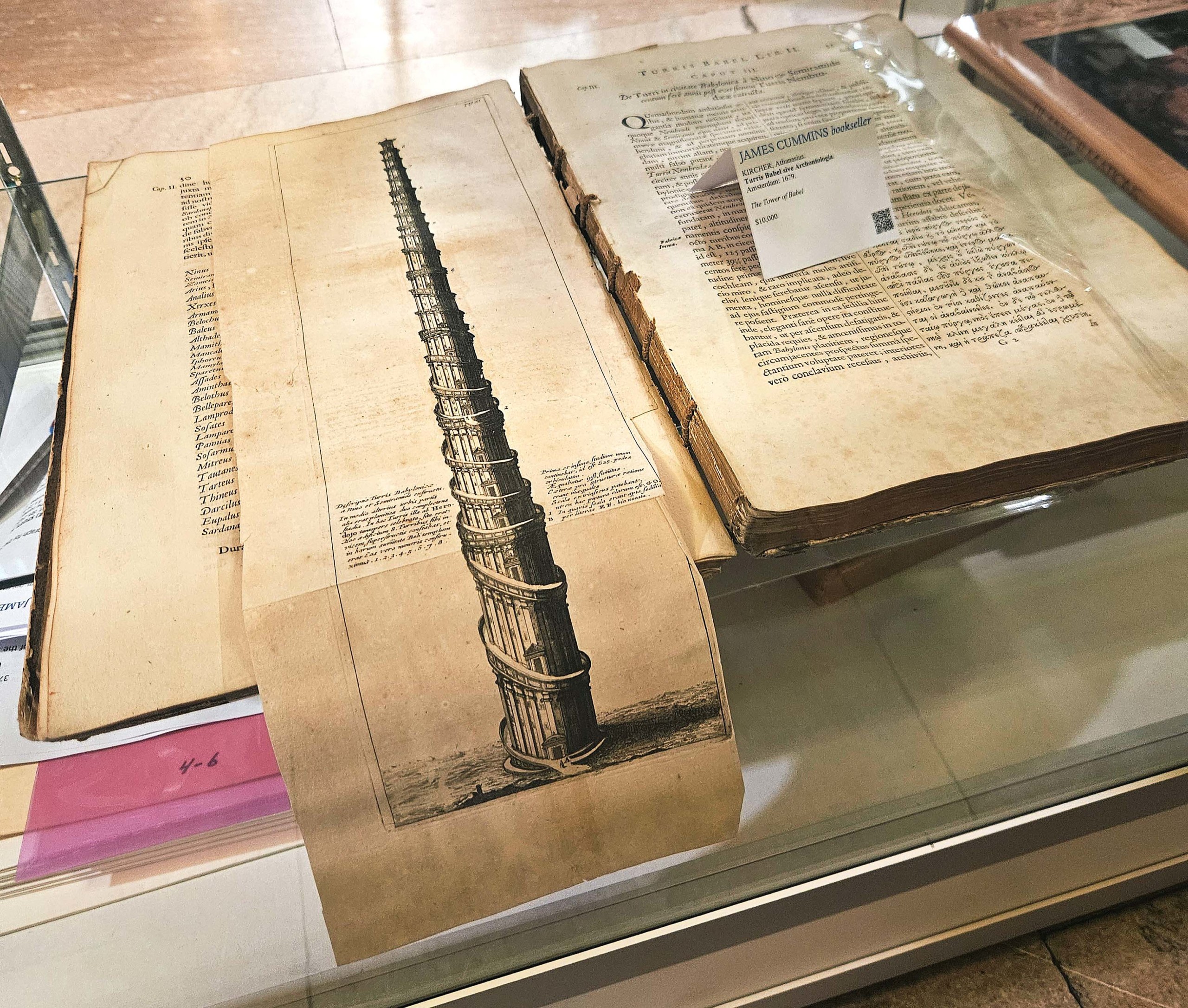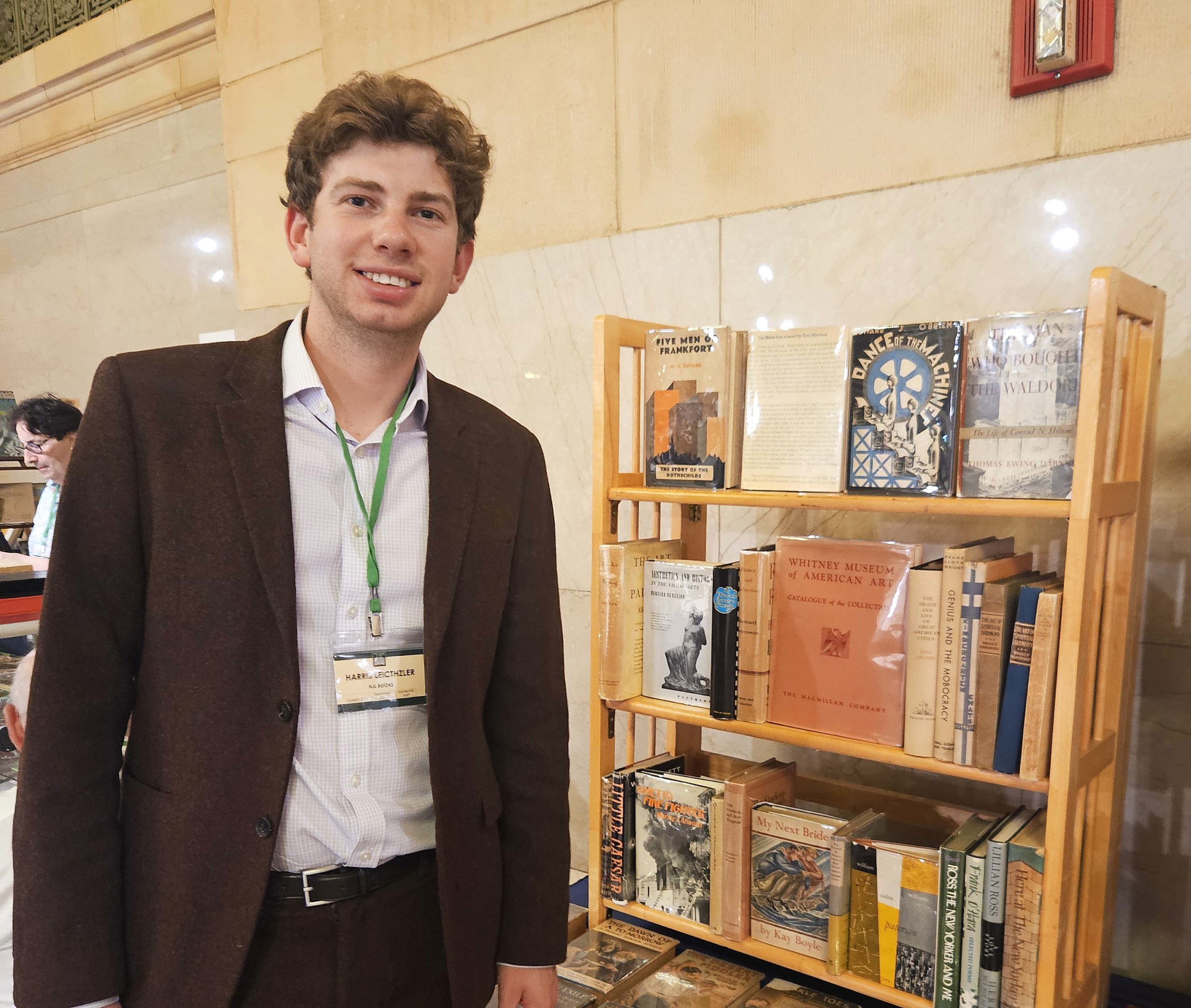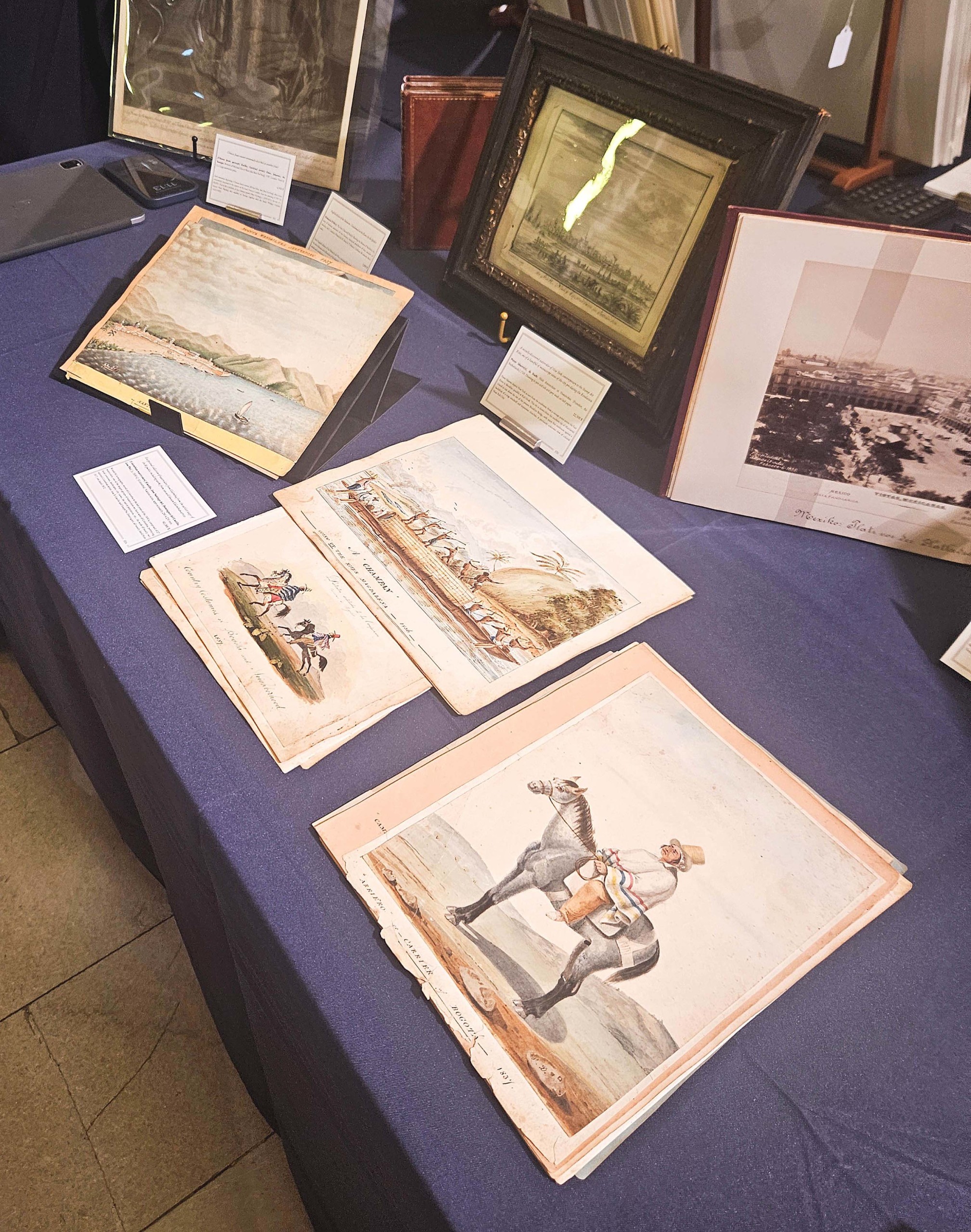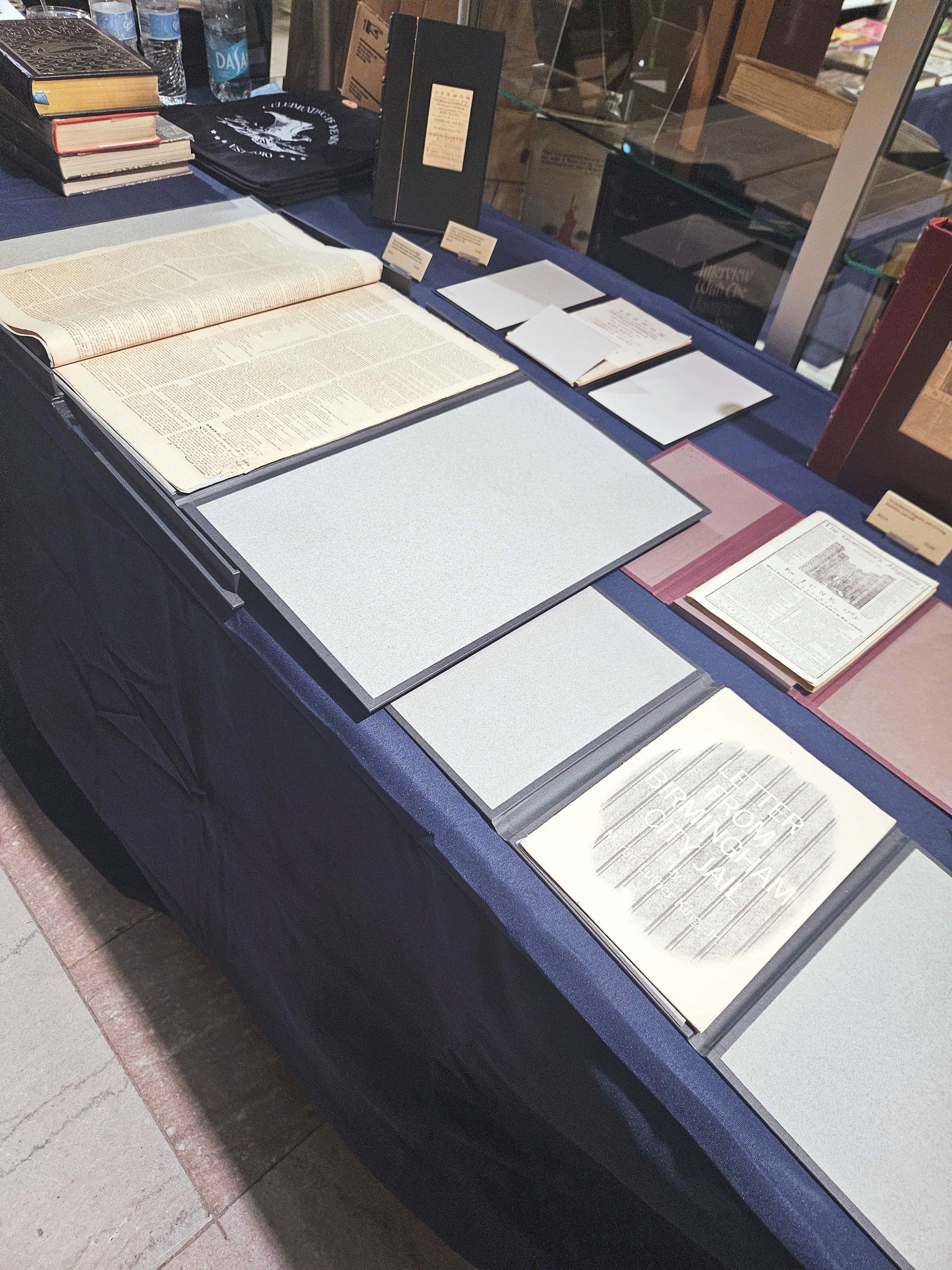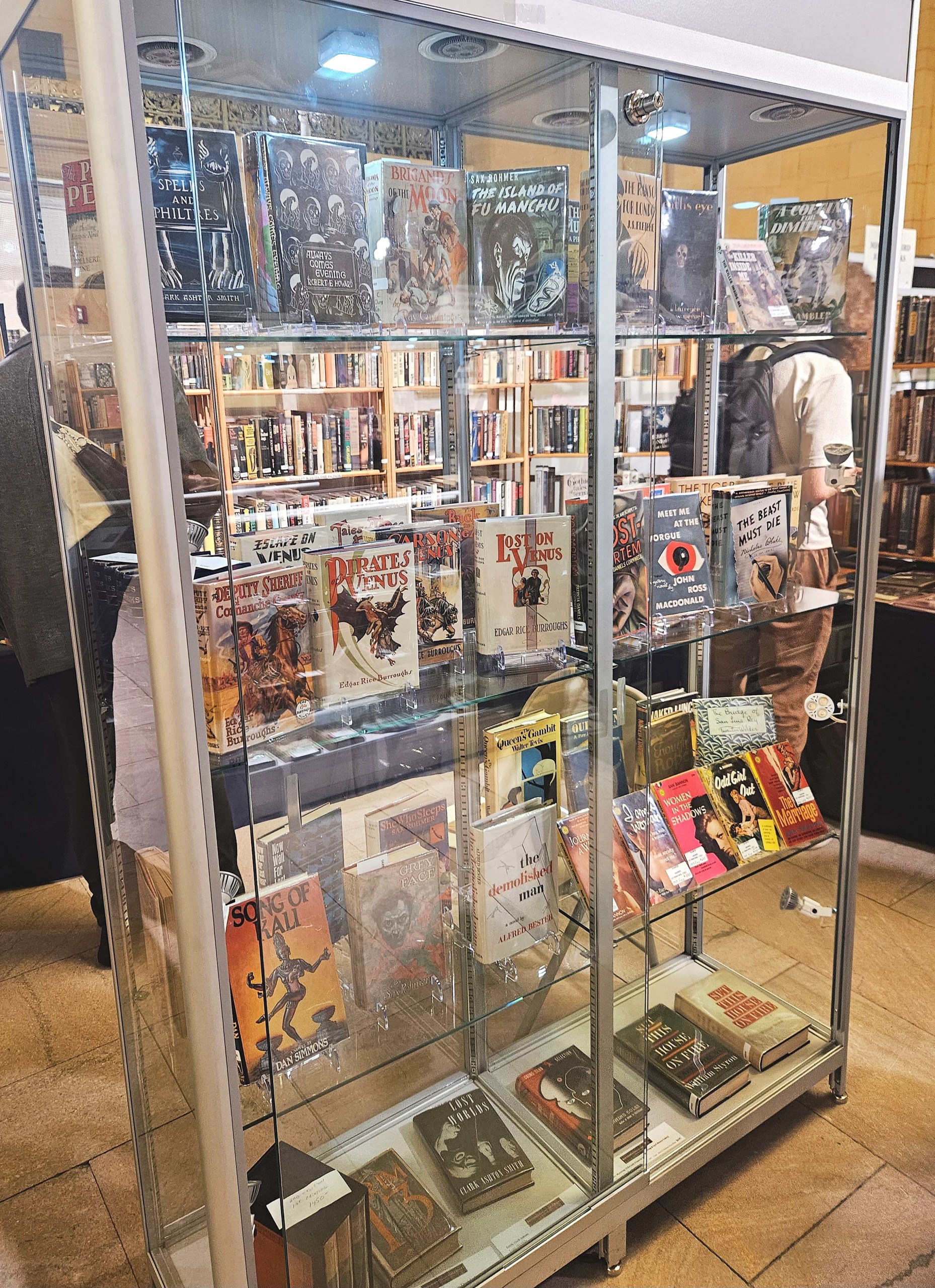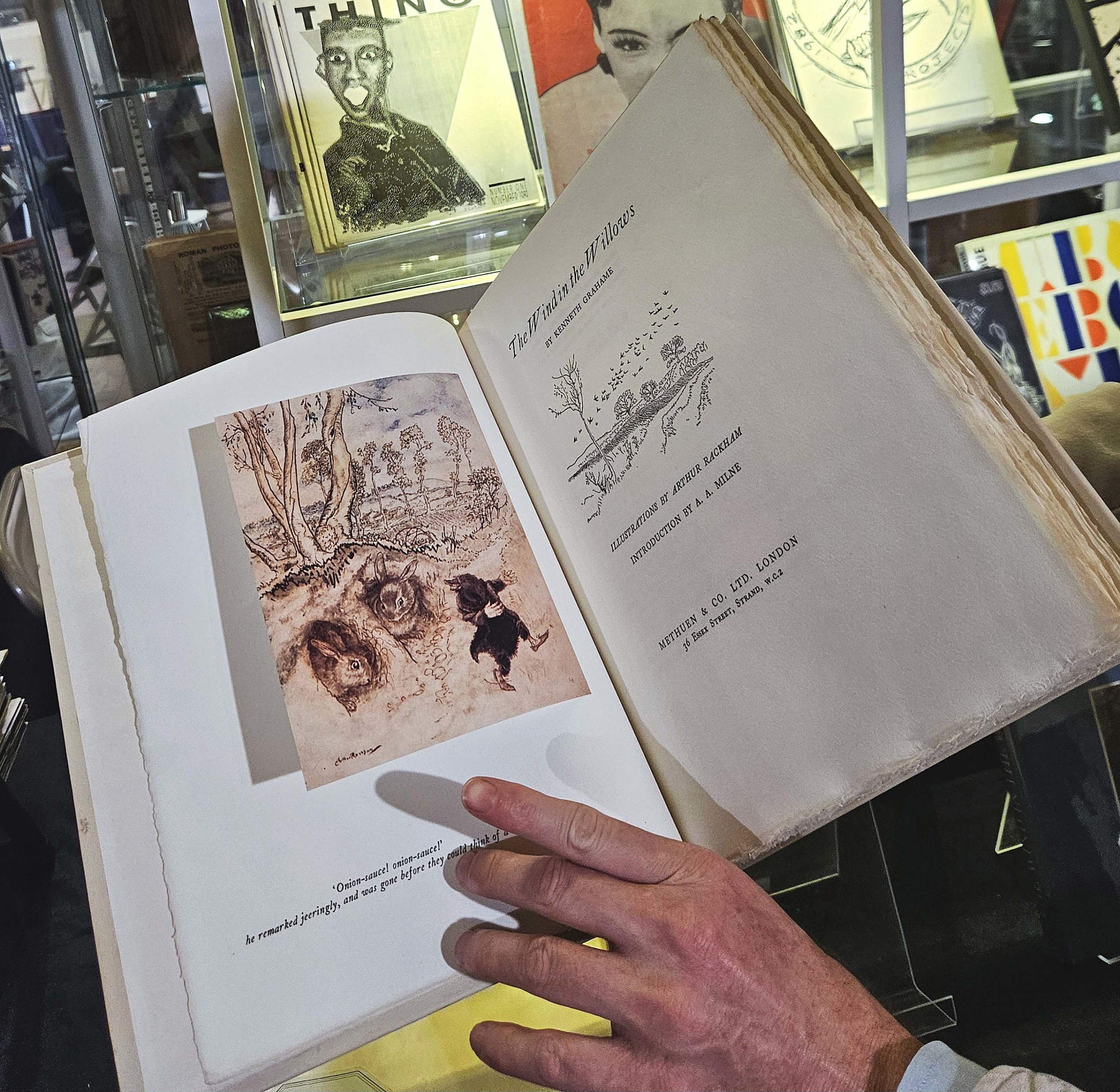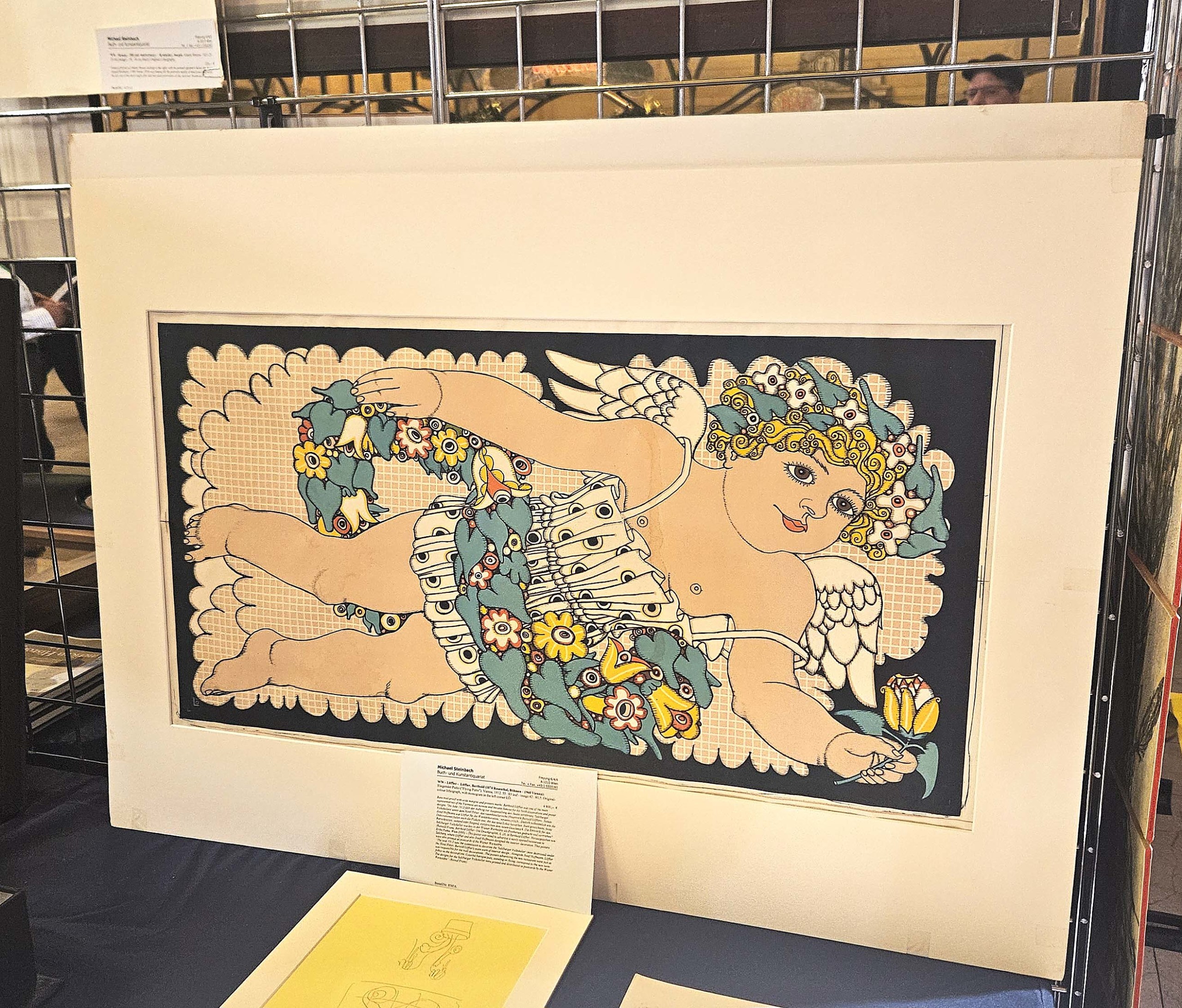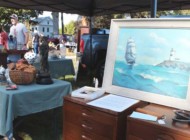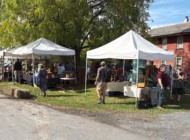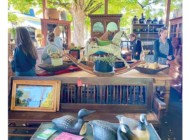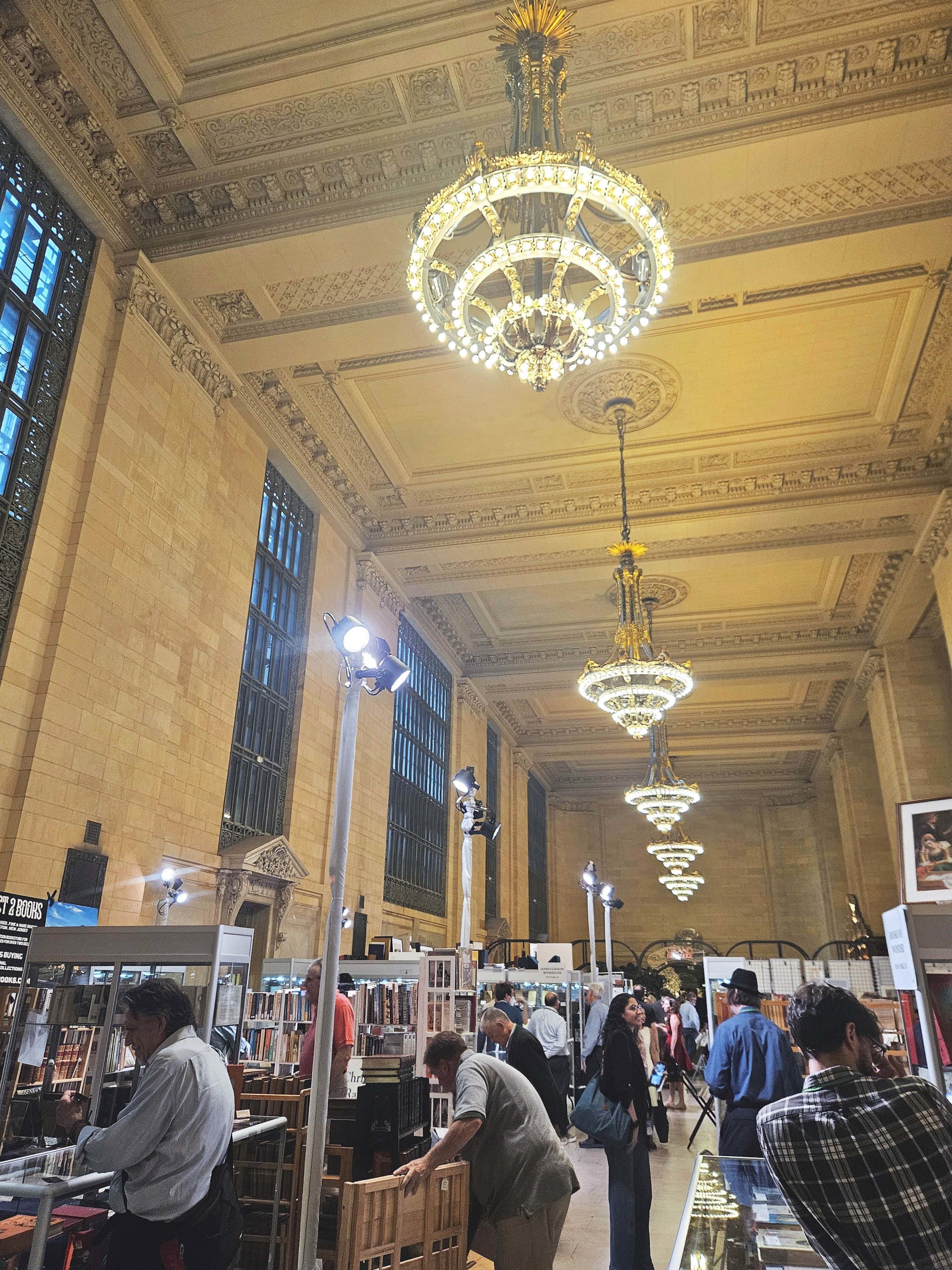
Preview night kicks off in Vanderbilt Hall.
Review & Onsite Photos by Caitlyn “Cat” Snell
NEW YORK CITY — Between September 26-28, if you were one of the more than the 200,000 people who pass through Grand Central Station daily, you had the unique opportunity to stumble upon the eclectic paper wares of the third annual Empire State Rare Book and Print Fair. Held in Vanderbilt Hall, just off one of the main entrances of Grand Central, 35 exhibitors graced the iconic location with books, documents and prints defined by their beauty, their historical prevalence and their rarity.
Beneath the soaring 55-foot ceilings and elegant chandeliers, the fair bustled with private collectors, institutions and the sought-after-audience of new collectors. While dealers connected with institutions such as the Metropolitan Museum of Art and those at Princeton and Yale Universities, new enthusiasts were drawn away from their usual hustle home to pursue the wares. For showrunners Edward and Eve Lemon of Fine Book Fairs, the location accomplished their goals of bringing together “amazing items with beautiful spaces,” as well as “bring[ing] in people who are otherwise unexposed” to this world of rare book and print dealing.
The location drew both patrons as well as dealers who were tantalized not only by the fair’s central location but also by its iconic nature. For dealers new to the Empire State fair, like Michael Laird Rare Books, the location was magnetic. Laird had passed through the station numerous times while traveling from dealings in New York to Lockhart, Texas, where he is based. The opportunity to attend a fair in Grand Central felt personal and exciting, and he exhibited eye-catching pieces like a 1996 handmade sewn book of contour portraits made by outsider artist Carol W. Crabtree.
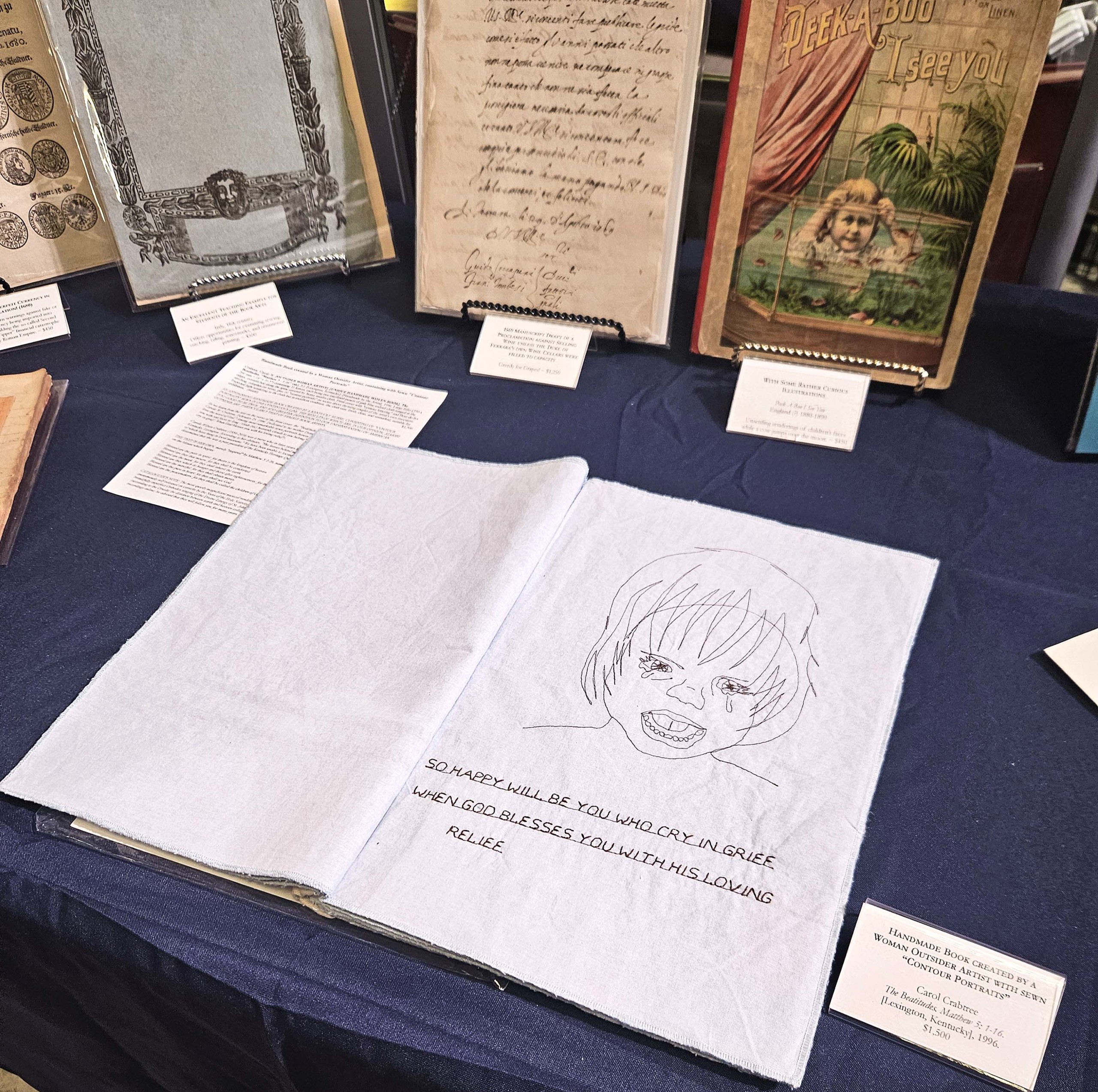
This book, handmade by a Kentucky nurse, featured 11 contour portraits and was offered by Michael Laird Rare Books. Lockhart, Texas.
Returning vendors were also drawn to the venue, such as Peter Harrington Rare Books. The firm has two locations in London and, as of the September 17, they opened their first New York City-based gallery. Specialist Sammy Jay confided that their booth at the fair only exhibited the “tip of the iceberg” of what they had to offer. One stunning collection on display was a complete run of Black Orpheus, a journal of African and Afro-American literature out of Sub-Saharan Africa, edited by Ulli Beier and illustrated by Susanne Wenger.
International pieces were abundant as Antiquariat Michael Steinbach arrived from Vienna, Austria, to display pieces like a 1912 original-color lithograph “Fliegender Putto” or “Flying Putto.” This stunning trail-proof made by Bertold Löffler depicts a cherub in his Art Nouveau style.
Jean-Luc Savignac, with Livres Dalleau, based out of New York City, also offered international pieces displaying finds such as a first edition of the 1984 L’Amant or The Lover by Marguerite Duras, displayed alongside a first American edition and the French 40th Anniversary Edition.
The Susan Teller Gallery brought items in conversation with the iconic space. Based in Jersey City, N.J., Teller has a keen interest in New York City as seen by the pieces she brought which reflect the rich artistic community fostered in the city, such as the Art Students League and the Union Square artists. On display was “Head of a Welder” by Ben Shahn; this gouache drawing was used multiple times throughout the artist’s life as a scale to keep murals life-sized and proportionate. This piece was especially poignant due to the exhibit of Shahn’s work currently on display at the Jewish Museum.
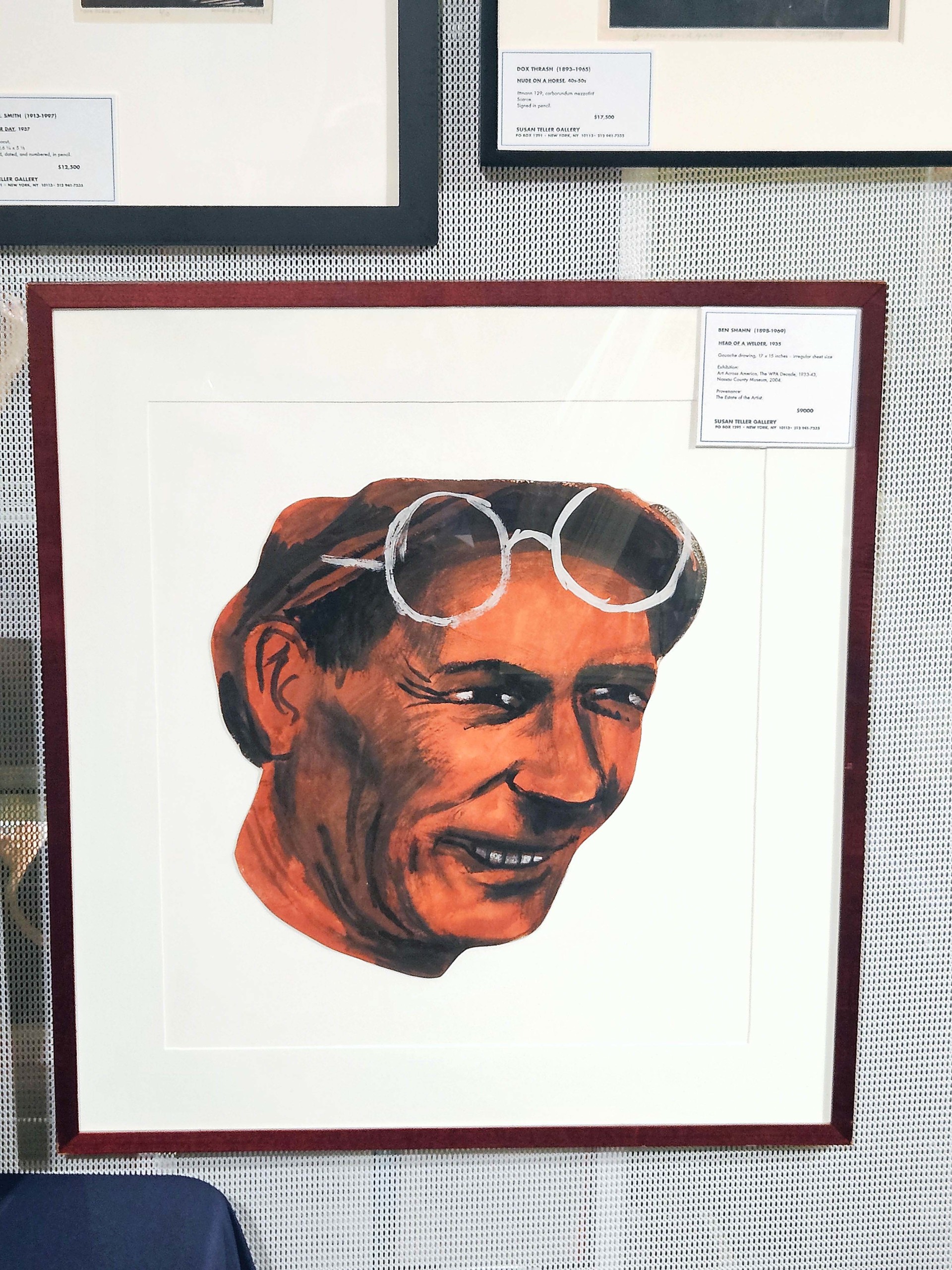
This 1935 drawing, “Head of a Welder” by Ben Shahn, was offered by Susan Teller Gallery, Jersey City, N.J.
William P. Carl – Fine Prints of Durham, N.C., featured a 1952 white line color woodcut, “Lighthouse” by Ferol Sibley Warthen, who also studied at the Art Students League and was prominent in the Provincetown, Mass., artistic community. Carl, who specializes in prints and woodcuts from 1870-1960, can attest to the quality of this labor-intensive artwork as a woodcut artist in his own right, with his own work in the collection of the Smithsonian.
From Brooklyn, N.Y., Arthur Fournier Fine and Rare also offered items that spoke to the community through the interconnection of notable people. Fournier exhibited items with special provenance like Raymond Pettibon: the Books 1978-1998, which was inscribed by the author to Donald Nicholson-Smith. Nicholson-Smith, like Pettibon, was an important member of the social revolutionary group the Situationist International. Fournier also offered Nicholson-Smith’s collection of childhood books, which give a sentimental new look at the anarchist through books such as the limited 100th edition of The Wind in the Willows, written by Kenneth Grahame and illustrated by Arthur Rackham, alongside others from Nicholson-Smith’s boyhood collection.
Other objects were displayed that provided unique perspectives on the past, particularly through vernacular history. Maggs Bros Ltd of London had on display a rare collection of photos from Muncie Island that followed an anonymous family as they vacationed off of Long Island, N.Y. Directors Fuchsia Vorember and Mark Tewfik revealed that these family photo albums were recently unearthed from storage after more than 50 years. Featuring two albums of photos, one with hand-coloring, this collection offered a unique glimpse of what summering at Muncie Island would have looked before it was depleted in the 1930s for the building of the Ocean Highway Project.
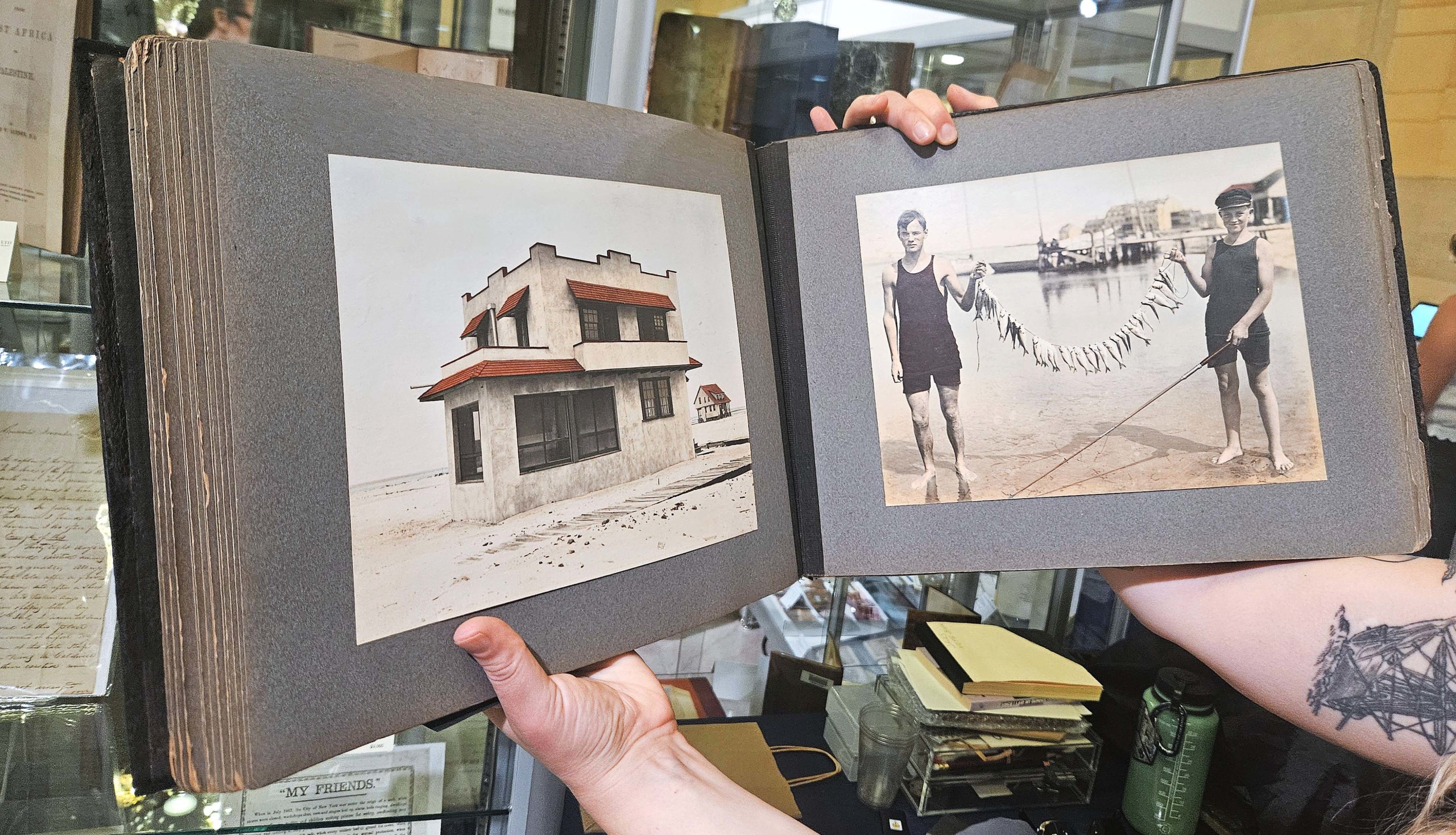
Family photo albums of Muncie Island offered by Maggs Bros Ltd, London.
Located in New York City, Erin Black with HS Rare Books exhibited a collection of unbound watercolors illuminating everyday life in Colombia around the 1830s. These paintings are a product of multiple painters, including two well-known Colombian artists: José S. Castillo and Joseph Pio Dominguez. Through their startlingly bright colors and talented artistry, their work offers a glimpse into local costumes, architecture and native life. Specializing in rare visual records particularly connected to South America, this was only one of the many compelling items HS Rare Books had on display among items of film history and a Seventeenth Century illustrated guitar manual.
Many items provided the chance to hold history in one’s hand, as well as one’s collection. Seth Kaller, White Plains, N.Y., had many tantalizing pieces of history on offer. A striking Civil War poster had commuters breaking from the foot-traffic of Grand Central Station to ask questions over the fencing separating the fair from the rush to the trains. “Men of Color,: To Arms! To Arms! Now or Never…” read the 1863 recruiting poster penned by Frederick Douglass, who saw his own sons enlist. This poster was shown alongside folk art by Charles A. Owen depicting the historic poster as well as other “iconic pieces” of American history for which Kaller is known.
The Nineteenth Century Rare Book and Photograph Shop, out of New York City, also offered historic items, specifically books and photography from moments that “contribute to mankind’s development.” One eye-catching item that an interested client called “museum-worthy” was a lithograph of the Apollo Lunar Module signed by all 12 moonwalkers, in addition to numerous people that worked behind the scenes to bring human beings into space. Stephan Loewentheil, president and founder of the business, also offered pieces such as an Elizabeth Barrett Browning manuscript notebook that included nine unpublished poems and a 1632 first issue of Shakespeare’s Second Folio.
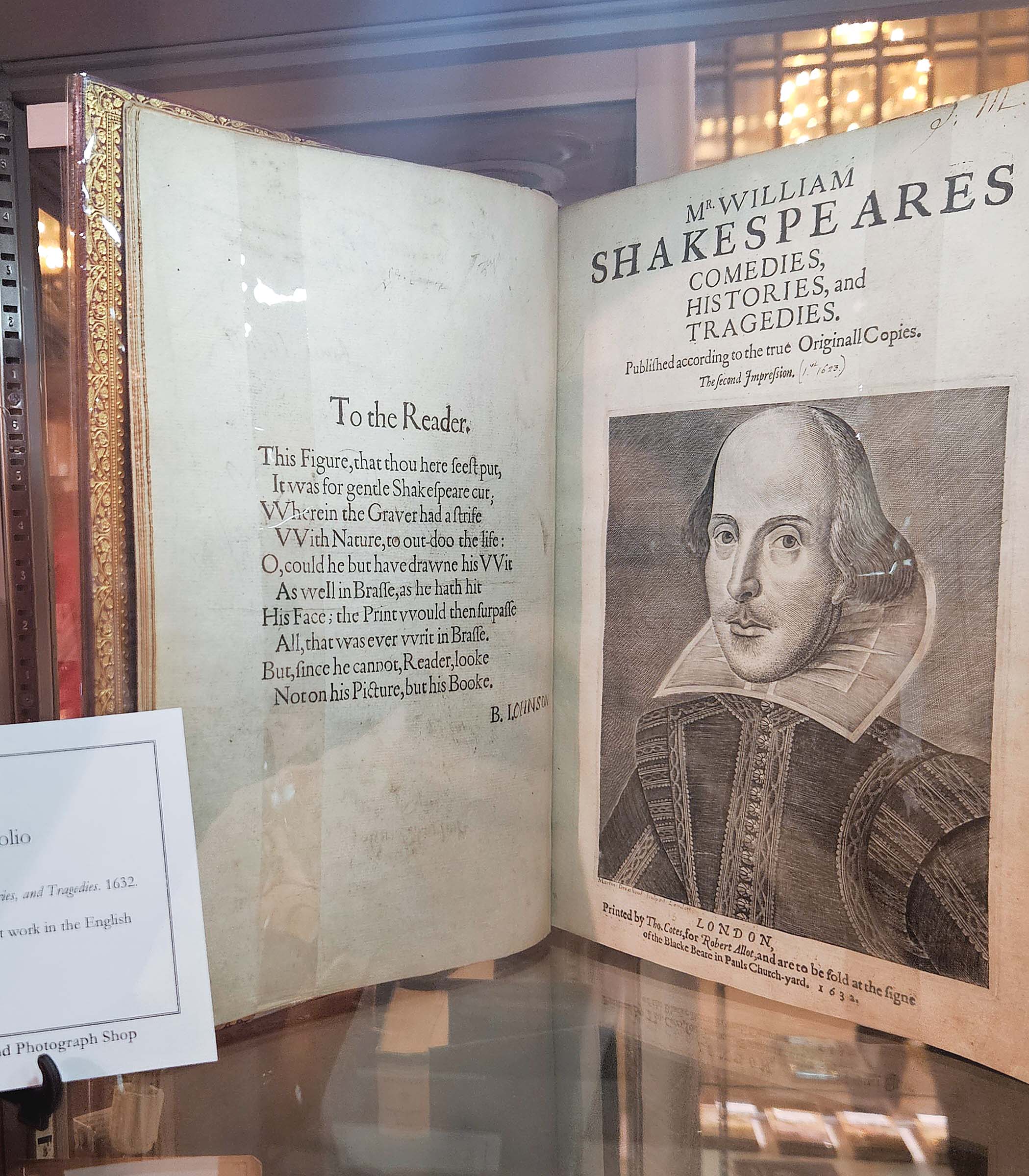
A first edition of Shakespeare’s Second Folio with extensive annotation by early owners as displayed by The Nineteenth Century Rare Book and Photograph Shop. New York City.
Katie Ibraliu, vice president of The Great Republic in Colorado Springs, Colo., also displayed historic American documents including printed pamphlets like a 1787 copy of the Pennsylvania Journal, which covered the constitutional convention in Philadelphia. This artifact is particularly compelling as the news coverage of the historic moment appears not on the front page but rather on the third page.
The transmission of information has changed drastically from the beginning of the printed word, and one offering by HJL Books expounded on that. Hailing from London, Harris J. Lechtzier established his business in the spring of this year and specializes in unique smaller titles with relevance in today’s world. Dance of the Machines by Edward J. O’Brien is a keen example of this. Written in 1929, the book laments the mechanization of literature due to the dawn of the typewriter. Though it seems to be an overreaction, the book’s central question feels relevant in the current digital world as it asks, “Can art survive the machine?”
Madison Lynch of Ageless Literature answered with an embrace of the changing industry. Out of Pinellas County, Fla., Ageless Literature is an online marketplace for rare books. A sponsor of the Empire State Rare Book Fair and an exhibitor, they had many exciting items on display, including a 1513 copy of Poeticon Astronomicon by Gaius Julius Hyginus. They offered an illustrated copy of the book that introduced European readers to allegorical celestial representations, like the zodiac symbols.
A 1513 copy of Poeticon Astronomicon with 47 half-page woodcuts offered by Ageless Literature. Pinellas County, Fla.
Though times may change, the fair also saw many timeless pieces on offer. James Cummins Bookseller from New York City had many items from prominent Nineteenth and Twentieth Century authors and artists, such as Walt Whitman, Andy Warhol and Audre Lorde. Though a true generalist, they also offered a 1679 copy of Turris Babel, sive Archontologia by Athanasius Kircher, which depicted among its 22 engraved illustrations, the Tower of Babel. Mike Uhde and Seon Cumberbatch of Act 2 Books brought an array from their store in Flemington, N.J., including famous names. Among their offerings was a 1927 signed first presentation edition of We by Charles Lindberg. Richard Mori, Mori Books, Franklin, N.H., brought books ranging from pristine pulp novels to illustrated medical books, and a signed copy of Lolita by Vladimir Nabokov.
Valentina Cordero of Owl of Minerva Rare Books, from West New York, N.J., also featured a once-banned book on display. Alongside items like a signed limited edition copy of Einstein’s writings, and a 1670 first Latin edition of Hobbes’ Leviathan, was the particularly rare copy of Historiae Ecclesisticae by Noel Alexander. Banned by the Pope and subject to book burnings, the copy Cordero had on display was a rare surviving first edition of the two volumes published in 1681 and 1683.
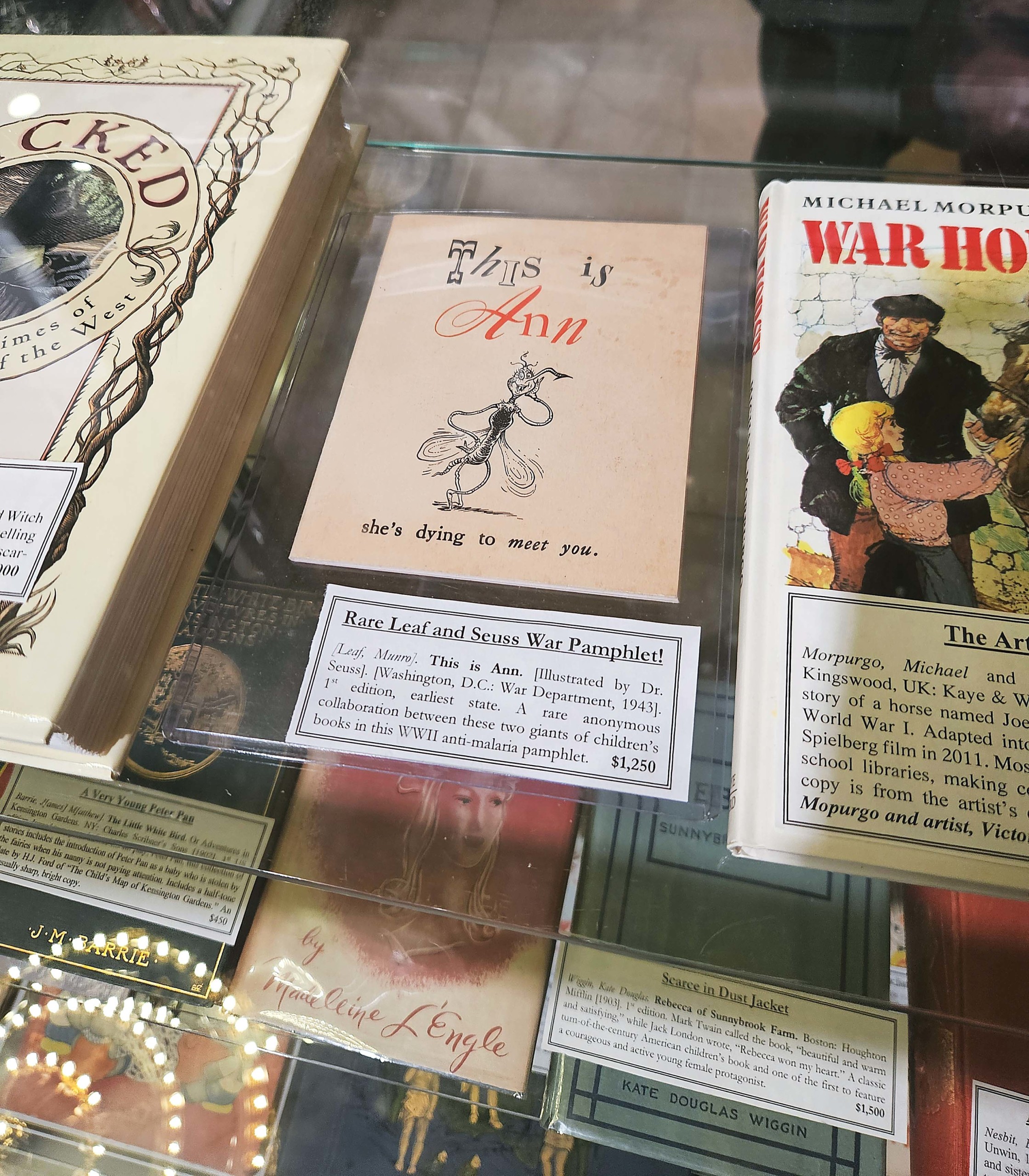
This is Ann, a war-department sponsored work by Dr Suess offered by Books of Wonder, New York City.
Another rare surviving paperwork was a This is Ann anti-malaria pamphlet given to soldiers in World War II that was exhibited by Books of Wonder out of New York City. Peter Glassman and Chris Heim disclosed that these booklets were meant to be read and thrown away. The pamphlets represent a monumental collaboration between Dr Seuss and Munro Leaf. Additionally, they shed light on the minute details of the war as the pamphlets were sponsored by the War Department in 1943 in the hopes to educate troops to take precautions against the disease.
The value of other books was defined by their beauty. Brenner’s Collectable Books from Manasquan, N.J., offered a collection of books with stunning art and quality. Notable was Michael Brenner’s collection of first editions with pristine dust jackets, such as featured novels from Edgar Rice Burroughs’ Venus series. These competed for attention alongside Brenner’s array of signed first printing copies of 1950s and 1960s lesbian pulp novels with striking covers in immaculate condition that visually “popped.”
Captain Ahab’s Rare Books from Stephenson, Va., specializes in “beautiful books,” with owner Amir Naghib stating that the artistry of a well-made book is “magic.” Among his picturesque offerings were titles ranging from Save Me the Waltz by Zelda Fitzgerald to a keepsake volume of The New Yorker magazine. One particularly memorable piece Naghib had on display was a signed deluxe edition of The Vermont Notebook by John Ashbery and Joe Brainard. With an original ink illustration, quality heavy-weight paper and a beautiful cloth backstrip, it was a prime example of the quality books that Naghib offers.
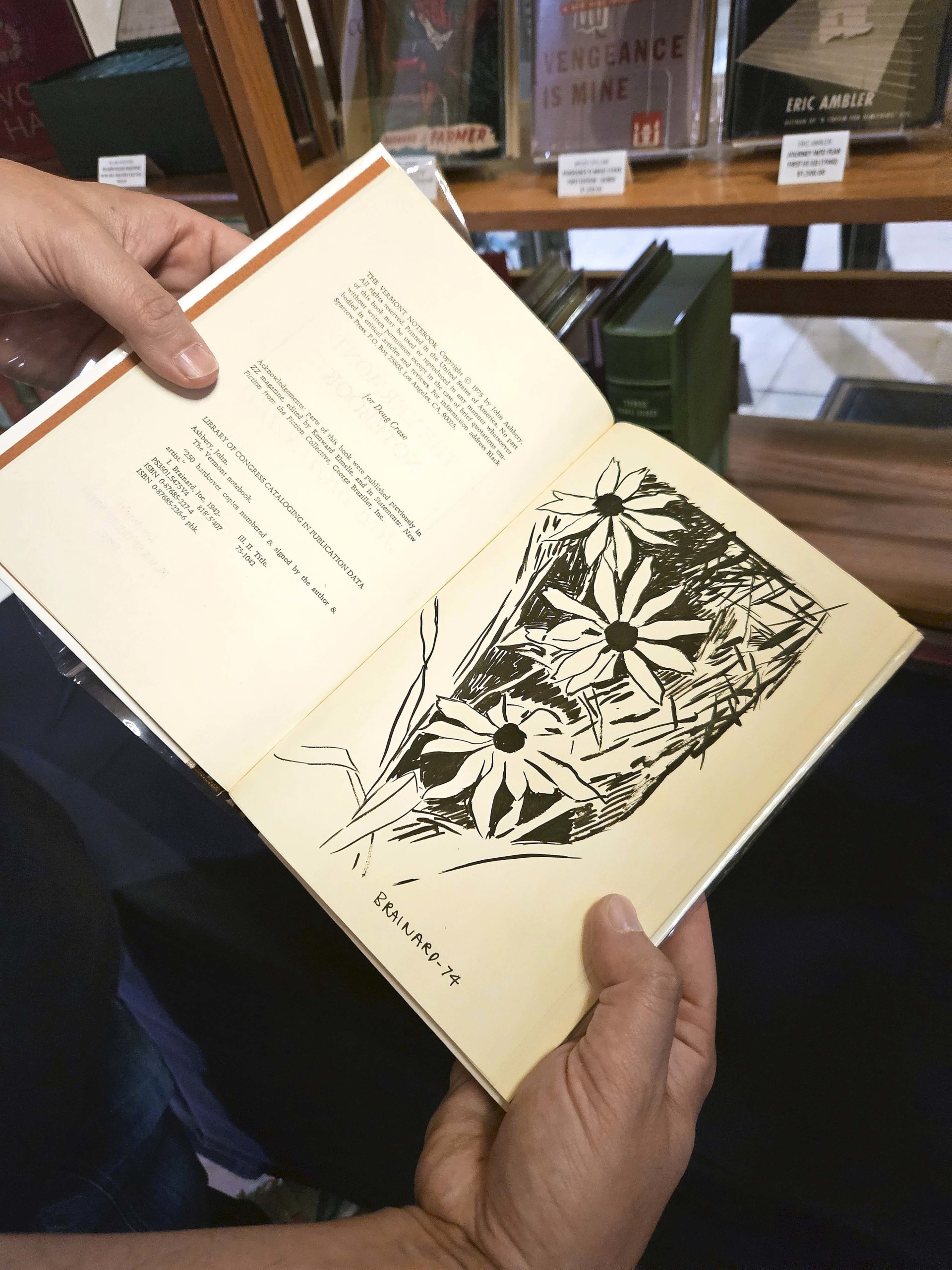
An original ink illustration in The Vermont Notebook offered by Captain Ahab’s Rare Books, Stephenson, Va.
The artistry of the printed word could be found all around the fair. Based in New York City, Michael R. Weintraub brought many stunning items including an artist book: La Loïe Fuller by Roger Marx and Pierre Roche. A tribute to one of Roche’s favorite subjects, Loïe Fuller, a visionary of modern dance, this book presented 17 gypsographs, which captured the dynamic beauty of Fuller’s art.
Michael Verne of The Verne Collection added to the beauty on display with his array of Japanese prints. Of the many works he had on display, that of Yuko Kimura was particularly evocative. On handmade paper, Kimura captured a quiet and resonant meditation on the concept of wabi-sabi, and the beauty of imperfection. Amidst the buzzing atmosphere of the fair, Verne spoke optimistically about the future of the fair. Reminiscing about dealing at the first Armory book fair, Verne pointed to the same feeling in Grand Central. Being a part of the Empire State Fair was to him “being there at the beginning” of something great.
Fine Book Fairs’ next event is the Rare Book Collecting Festival and Fair, Washington DC, on October 24-26. For more information, www.finefairs.com.

